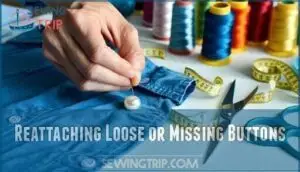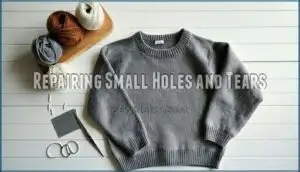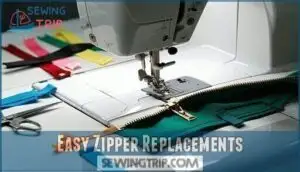This site is supported by our readers. We may earn a commission, at no cost to you, if you purchase through links.
 That ripped seam or missing button doesn’t mean your favorite jacket needs to end up in a landfill. With a few basic tools and some straightforward techniques, you can repair most clothing damage right at home.
That ripped seam or missing button doesn’t mean your favorite jacket needs to end up in a landfill. With a few basic tools and some straightforward techniques, you can repair most clothing damage right at home.
Whether you’re reattaching a button in five minutes or tackling a torn pocket, these practical sewing ideas will help you extend the life of your wardrobe while saving money and reducing waste.
Table Of Contents
Key Takeaways
- You can handle most clothing repairs at home with just basic supplies like needles, thread in common colors, fabric patches, and optional no-sew tools like fabric glue or iron-on patches—everything fits in a shoebox and costs less than replacing garments.
- Matching your repair method to the damage type makes fixes last longer: use darning for knits and socks, sewn patches for heavy-wear areas like knees, and appropriate thread-to-fabric pairing (cotton thread for natural fibers, polyester for synthetics and stretch).
- Visible mending techniques like sashiko stitching, decorative patchwork, and embroidered repairs transform necessary fixes into intentional design features that celebrate your clothing’s history instead of hiding damage.
- Repairing clothes delivers measurable environmental and economic benefits—fixing one cotton t-shirt saves over 7.5 kg of CO₂ emissions, and for every five items you repair, you’ll avoid buying four new ones while keeping textiles out of landfills.
Essential Tools and Materials for Clothing Repair
You can’t fix what you don’t have, and a few basic supplies make the difference between a quick repair and a ruined garment.
With the right tools on hand, those wardrobe emergencies become quick fixes you can knock out in an afternoon.
Here’s what you’ll need to tackle most clothing repairs without spending a fortune or taking up much storage space.
Must-Have Sewing Supplies for Beginners
You don’t need a fully stocked sewing studio to start fixing your own clothes—just a handful of basic supplies that fit in a shoebox.
A hand sewing kit with needles and thread in common colors covers most repairs. Add measuring tools like a tape measure, fabric markers for marking hems, and a seam ripper for undoing mistakes.
With this basic toolkit, you can handle anything from popped buttons to pants that drag on the floor.
Choosing The Right Thread and Needles
Matching your thread to the fabric and needle to the job makes the difference between repairs that hold and ones that unravel after a few wears. Cotton thread works best for natural fibers, while polyester thread works with synthetics and stretchy fabrics. Needle point types matter too—sharp needles pierce tightly woven cotton, ballpoint needles slip between knit fibers without snagging.
Your essential sewing kit should include:
- Hand sewing needles in assorted sizes for light to heavy fabric weight match
- Machine needle sizes ranging from 70/10 for delicates to 100/16 for denim
- All-purpose polyester thread in basic colors for most repairs
- Cotton thread for natural fabrics like linen and chambray
- Matching thread fiber types to your garment’s original construction
Fabrics and Patches for Different Repairs
The right patch material can make a repair nearly invisible or turn it into a bold statement—it all depends on what you’re fixing and the look you want. Cotton patches work for woven fabric repair like denim or canvas, while knit fabric repair needs stretchy jersey or rib knit. Iron-on patches offer quick fixes, but sewn patches hold stronger on heavy-wear areas. Color matching patches to your garment keeps repairs discreet.
| Fabric Type | Best Patch Material | Application Method |
|---|---|---|
| Denim/Canvas | Cotton twill, denim scraps | Sewn patches or iron-on patches |
| Knits/T-shirts | Jersey knit, ribbed fabric | Sewn with stretch stitch |
| Wool/Sweaters | Matching wool blend | Darning or sewn patches |
| Synthetics | Polyester blends | Iron-on or fabric glue |
| Delicates | Lightweight cotton, silk | Hand-sewn with fine thread |
Handy No-Sew Tools and Materials
You won’t always need a needle and thread—a hot iron or fabric glue can tackle plenty of fixes in half the time. Stock your no-sew toolkit with:
- Fabric glue – Secures hems and embellishments without stitching
- Iron-on patches and fusible hemming web – Heat-activated adhesives bond fabric instantly
- Chalk markers and fabric markers – Mark placement before applying iron-on adhesives
- Rivets and snaps – Add fasteners with a simple press tool
Quick and Simple Clothing Fixes
Not every clothing mishap needs a trip to the tailor. Most wardrobe emergencies can be fixed at home with basic skills and a few minutes of your time.
These four essential repairs will keep your favorite pieces wearable and looking sharp.
Reattaching Loose or Missing Buttons
A dangling button might seem like a minor annoyance, but catching it before it disappears into the laundry abyss or between couch cushions can save you from hunting through your junk drawer for a replacement that never quite matches.
Your sewing kit needs just a needle, thread that’s strong enough for the button type, and maybe a toothpick for shank creation if it’s a thick coat.
Match missing buttons by checking inside seams for spares, then sew on a button using a simple crisscross pattern with reinforcement methods like extra stitches through the base.
Hemming Pants and Skirts at Home
When your favorite jeans start dragging on the ground or that perfect skirt suddenly feels too long, you don’t need to hand over twenty bucks to a tailor—you just need about half an hour and some basic supplies.
Here’s your DIY hemming toolkit:
- Measuring tape for finding that perfect hem length
- Fabric chalk to mark your cutting line
- Sharp scissors that won’t fray edges
- Iron for crisp folds
- Needle and thread matching your fabric
Pin your new hemline, press the fold, and use simple hand stitches or a machine stitch—hemming techniques adapt to different fabric considerations, whether you’re working with denim or delicate silk.
These clothing alterations become second nature after your first try, and avoiding mistakes comes down to measuring twice before you cut.
Repairing Small Holes and Tears
That tiny hole in your sweater sleeve might look harmless now, but left alone, it’ll spread like a crack in a windshield—catching on everything until you’re left with a gaping tear. Quick action prevents tears from growing, and your repair approach depends on fabric type and hole size.
| Repair Method | Best For |
|---|---|
| Invisible mending | Knit fabrics, small snags |
| Fabric patches | Larger tears, worn areas |
| Darning wool | Socks, sweaters, woven items |
For tiny punctures, try fabric weaving—carefully pulling threads from a seam allowance and weaving them seamlessly across the gap.
When patching holes becomes necessary, choose patches matching your garment’s weight and texture, then secure them with hand stitching or fabric glue. Darning creates sturdy repairs for socks and knitwear, while proper patch selection transforms mending clothes into an invisible art form.
Easy Zipper Replacements
Broken zippers don’t have to mean the end of your favorite jacket—swapping one out takes about fifteen minutes and costs less than a coffee. Start by checking if you need a full zipper replacement or just a slider fix—sometimes the pull tab fails while the teeth stay intact.
Remove the old zipper with a seam ripper, pin the new one carefully to maintain proper zipper alignment, and stitch it in place using a zipper foot attachment. This DIY clothing repair saves you from tossing perfectly good garments, and once you’ve mastered zipper fixes, you’ll repair everything from coat zippers to pants closures without breaking a sweat.
Creative Sewing Ideas for Visible Mending
Not every repair needs to hide in the shadows. Visible mending transforms necessary fixes into creative statements that celebrate your clothing’s history rather than conceal it.
These techniques let you transform damage into wearable art.
Decorative Patchwork Techniques
Patchwork isn’t just about covering up damage—it’s your chance to turn a worn spot into the most interesting part of your outfit. Mix contrasting fabrics for bold patchwork aesthetics or choose coordinating colors for subtler visible mending.
Try strategic patch placement over holes and experiment with stitch variations—running stitches, blanket stitches, or zigzags—to create textile art that transforms patching holes into intentional fabric manipulation and upcycling.
Sashiko and Embroidery Repairs
Sashiko stitching—the traditional Japanese technique of running stitch patterns—turns a simple repair into rhythmic meditation with needle and thread. These geometric sashiko patterns add texture and visual interest to your visible mending projects.
Try these approaches:
- Select contrasting thread colors against your fabric for bold statements
- Stretch fabric in an embroidery hoop for even tension during mending
- Layer embroidery stitches like chain stitch or French knots over darning for textile art effects
Your fabric selection and color palettes transform necessary repairs into wearable art.
Turning Damage Into Design Features
A ripped seam doesn’t have to be a wardrobe failure—it can become your garment’s most interesting feature if you shift your perspective from hiding damage to highlighting it. Visible mending styles embrace intentional distressing and creative embellishments that celebrate your clothing’s history. Consider artistic patch placement where tears naturally occur, or layer contrasting fabrics for upcycled aesthetics that blend textile art and design with practical repair.
These creative sewing ideas transform necessary repairs into intentional statements—your garment tells a story instead of hiding one.
| Damage Type | Design Transformation | Technique |
|---|---|---|
| Torn knee | Contrasting fabric window | Reverse appliqué |
| Frayed cuffs | Decorative binding | Bias tape edging |
| Stained area | Embroidered garden | Chain stitch clusters |
| Ripped pocket | Geometric patchwork | Mixed fabric collage |
| Worn elbow | Leather reinforcement | Saddle stitch accent |
Using Iron-on and Fabric Glue for Artistic Fixes
If you’re not confident with a needle and thread, iron-on patches and fabric glue offer a no-sew shortcut that still delivers professional-looking results with room for creative expression. Choose your method based on fabric compatibility and repair longevity:
- Iron-on patches work best on cotton and blends—heat activates the adhesive for quick clothing upcycling
- Fabric glue addresses artistic embellishments on delicate materials where heat might damage fibers
- Sewn patches outlast adhesive options but require more skill
Glue vs. sewing depends on creative applications and how long you need the fix to last.
Advanced Clothing Repair and Upcycling
Got the hang of basic repairs? Time to move into territory that actually transforms your wardrobe.
These advanced techniques can rescue damaged pieces and revive outdated ones—turning you into someone who can fix almost anything in your closet.
Ready to elevate your repair skills and truly transform your wardrobe?
Darning Techniques for Woven Fabrics
When worn fibers create holes in your favorite sweater or work pants, darning offers a sturdy fix that weaves new thread directly into the damaged area. You’ll use hand sewing to interlace thread across the hole, mimicking the fabric’s original structure.
Speed-weaving works well for quick textile repair, while invisible darning blends seamlessly into solid colors. Patterned darning and darning wool add decorative touches to visible mends. Darning looms help maintain tension during repair.
| Technique | Best For | Skill Level |
|---|---|---|
| Invisible darning | Solid-colored woven fabrics | Intermediate |
| Patterned darning | Visible repair with decorative effect | Beginner |
| Speed-weaving | Quick holes in sturdy material | Beginner |
| Swiss darning | Knit garments and fine weaving | Skilled |
Altering and Reshaping Garments
Beyond repairing holes and tears, you can reshape ill-fitting clothes to match your body or breathe new life into outdated styles with the right alteration techniques. Seam adjustments and fit customization transform baggy shirts into fitted pieces, while silhouette changes update dated cuts.
Fabric manipulation—like adding darts or taking in side seams—creates style transformation through DIY clothing alterations. These refashioning clothes methods work for everything from maternity alterations to completely reimagining a garment’s shape.
Upcycling Old Clothes Into New Styles
That forgotten sweater gathering dust in your closet doesn’t need to stay forgotten—upcycling transforms outdated or damaged pieces into something you’ll actually want to wear.
Cut oversized shirts into cropped tees, turn worn jeans into shorts, or add contrasting fabric panels to transform the silhouette.
Clothing upcycling bolsters sustainable fashion while giving you custom pieces that reflect your personal style evolution—wardrobe reinvention through creative reconstruction.
Combining Repairs With Textile Art
Your repairs can become stunning visual statements when you blend traditional visible mending techniques with textile art. Sashiko techniques, decorative darning, and patchwork designs transform tears into intentional features—creative upcycling that extends garment life while expressing your personal style. Nearly 43% of home mending projects in 2025 incorporated artistic elements, and textile mending with embroidery keeps garments wearable longer than invisible fixes. The Edinburgh Street Stitchers demonstrate how mending can promote sustainable clothing practices.
- Layer sashiko stitching over worn knee patches for geometric texture
- Combine fabric patches with kantha-inspired embroidery around necklines
- Apply decorative darning across elbow tears using contrasting thread colors
These artistic mending benefits go beyond aesthetics—wearers retain artistically repaired pieces for two additional years on average, supporting clothing upcycling while reducing waste.
Preventative Maintenance and Sustainable Practices
The smartest way to handle repairs is to prevent damage in the first place. By catching problems early, storing your clothes with care, and figuring out what needs attention first, you’ll keep your wardrobe looking its best for much longer.
Plus, these simple habits are good news for both your wallet and the environment.
Spotting and Reinforcing Weak Areas
Your clothes aren’t shy about showing you exactly where they’re about to fail—you just need to know where to look. Check seam stress points like underarms and crotch areas for fraying threads. Run your fingers along pocket edges to catch fabric weakness before it tears through.
Preventative stitching with reinforcement materials stops small issues cold, protecting high-friction zones before repair techniques become necessary.
Proper Washing and Storage Habits
How you treat your garments between wears matters just as much as fixing them when they fail. Start with fabric care basics: read those labels and choose pH-neutral detergents that won’t break down fibers.
Toss delicates into mesh bags before washing to prevent snags. When storing clothes, give them breathing room—cramped closets create weak spot prevention nightmares.
These preventative clothing maintenance habits are your best defense for extending garment life.
Assessing Damage and Prioritizing Repairs
Not every tear deserves the same urgency—learning to triage your wardrobe like a medic on a battlefield keeps you from wasting time on lost causes while neglecting salvageable favorites.
Check damage severity first: small holes beat gaping tears. Factor in fabric type and garment value—your favorite jeans warrant more attention than a worn gym shirt.
Match repair techniques to your skills, tackling simple fixes before complex clothing repairs.
Environmental and Economic Benefits of Repair
Repairing one cotton t-shirt instead of buying new saves over 7.5 kg CO₂—roughly equal to 25 hours of ironing—making each stitch a meaningful blow against waste. You’ll slash carbon emissions, prevent textile waste from hitting landfills, and rack up economic savings while extending the lifespan of clothes.
For every five items you fix, you’ll displace four new purchases, keeping money in your pocket and supporting the circular economy. Sustainable fashion isn’t just trendy talk—it’s about clothing longevity and waste reduction that measurably cut your environmental footprint.
Sadly, most textiles end up in landfills or incinerators.
Frequently Asked Questions (FAQs)
What sewing techniques are used in clothing repair?
Stitching back together what’s fallen apart isn’t rocket science—just a handful of basic sewing techniques for repair. Invisible mending, reinforcement techniques, and seam repair methods address most clothing damage, while fabric weave repair confronts holes in knits.
What is DIY clothing repair?
DIY clothing repair means fixing your own garments at home using basic tools and techniques. It covers everything from reattaching buttons to patching holes, giving you the repair skill levels and repair accessibility to tackle simple fixes without professional help.
It’s a practical way to save money and pick up real-world mending skills at the same time.
What are some easy sewing ideas for clothing alterations?
Making changes to your clothes doesn’t have to be complicated—sometimes, just a few tweaks can make a world of difference. Consider taking in the sides with seam adjustments, refining the waistline for a better fit, fixing the sleeves, or simply altering the length.
These DIY alterations improve fit without professional sewing skills, transforming clothing through basic alteration techniques.
Why should you repair your clothes?
When you mend your clothes, you not only help them last longer—you also sharpen your skills and start to develop your own sense of style.
Cost savings add up quickly—repairing clothes reduces waste and encourages sustainable fashion.
Wardrobe maintenance through simple fixes means you’ll spend less replacing items you already love.
How can you save money repairing clothes?
It’s funny how buying new seems cheaper until you add it up. DIY clothing repair costs pennies compared to replacement.
A button reattachment saves $30, hemming pants saves $20, and patching holes extends garment life for under $5, delivering immediate repair cost savings.
How do I make my clothes fit better without sewing?
Try clothing shapers like waist cinchers or garment clips for instant adjustments. Fabric tape provides temporary fixes for hems, while belt tricks and strategic tucking offer no-sew alterations that improve fit immediately without compromising your sustainable wardrobe maintenance routine.
How do I fix a frayed collar?
Collars that fray seem to announce their wear at the worst possible moment. Trim loose threads, then apply fabric interfacing underneath for stability.
Use a tight zigzag stitch or decorative embroidery along frayed edges, transforming collar fray prevention into a style upgrade.
What causes fabric pilling and how to remove it?
Friction from wear creates pilling as loose fibers tangle into balls on fabric surfaces.
Remove pills using a fabric shaver, sweater comb, or razor, working gently to avoid damaging the weave.
Prevent future pilling by washing clothes inside-out and choosing tightly woven fabrics.
When should I repair versus replace clothing?
Like a gardener deciding whether to prune or pull a wilting plant, you’ll need to weigh repair cost analysis against the garment’s remaining life.
Consider your repair skill level, future repair likelihood, and sentimental value matters—especially for beloved pieces worth extending clothing lifespan through careful clothing repair and maintenance techniques.
How do I fix stretched out elastic waistbands?
You can replace stretched elastic by opening the waistband casing, removing the old elastic, and weaving new elastic through using a safety pin.
For quick temporary fixes, tack the stretched elastic at intervals with basic sewing techniques for repair to restore tension and improve your wardrobe maintenance.
Conclusion
Americans discard over 11 million tons of textile waste yearly, yet most damage takes just minutes to fix. Each repair you complete keeps clothing out of landfills while building skills that last a lifetime.
These sewing ideas for clothing repair transform you from passive consumer to active caretaker of your wardrobe. Your needle and thread become tools of resistance against throwaway culture—one stitch reinforcing both fabric and your commitment to sustainable living.
- https://threadsmonthly.com/repair-clothes-statistics/
- https://journals.sagepub.com/doi/full/10.1177/00405175221123067
- https://www.npr.org/2023/05/22/1177552573/extend-the-life-of-your-clothes-with-visible-mending
- https://www.eileenfisher.com/a-sustainable-life/journal/repair-care/visible-mending-101-stitching.html
- https://twyg.co.za/explainer-why-mending-matters/













